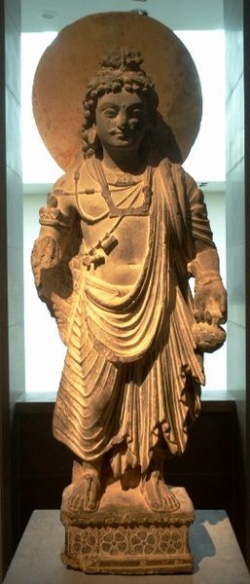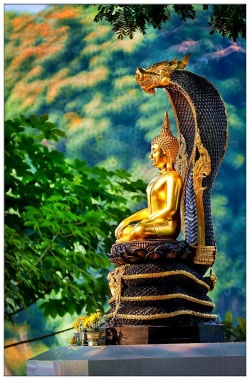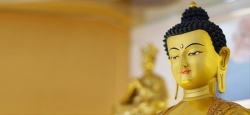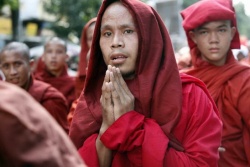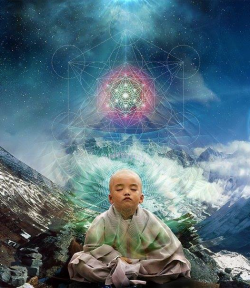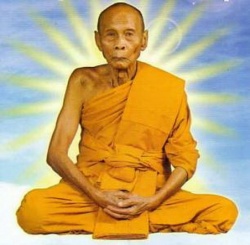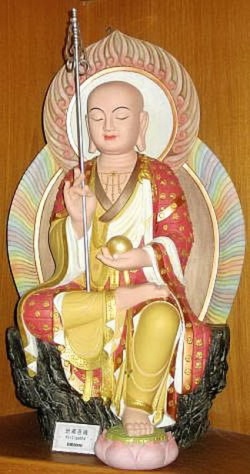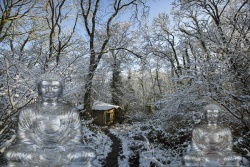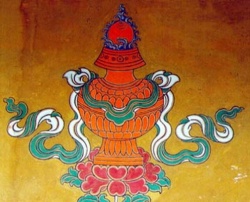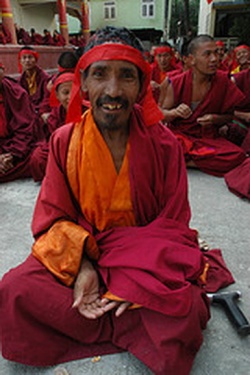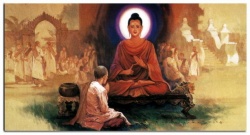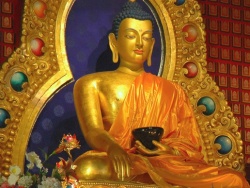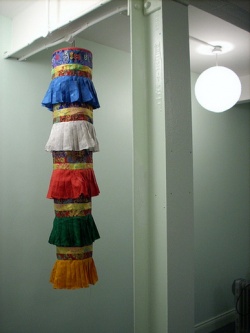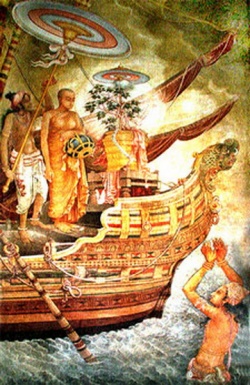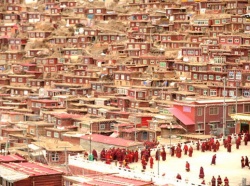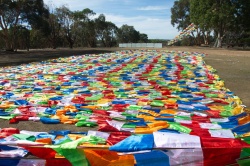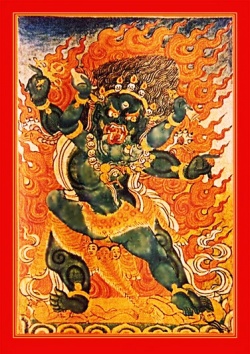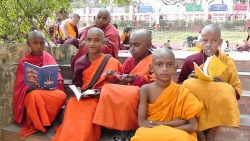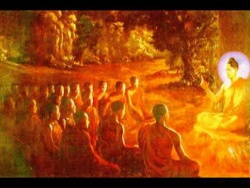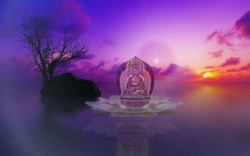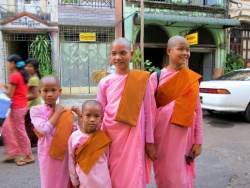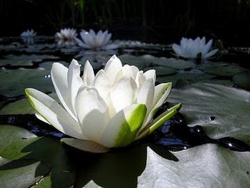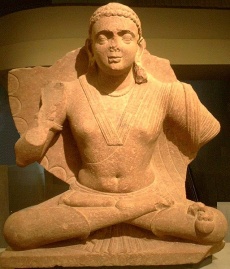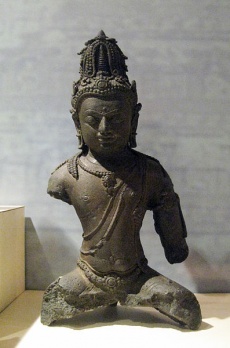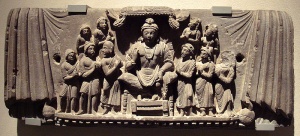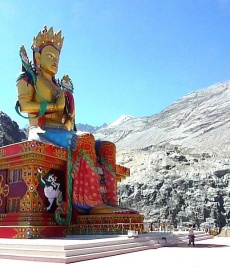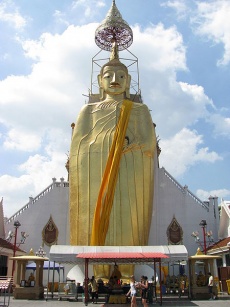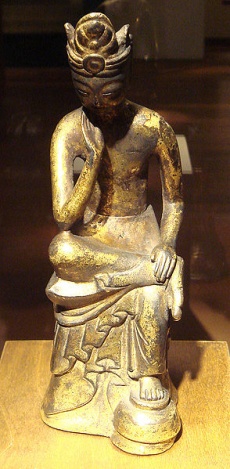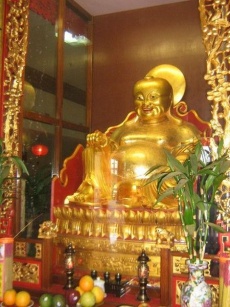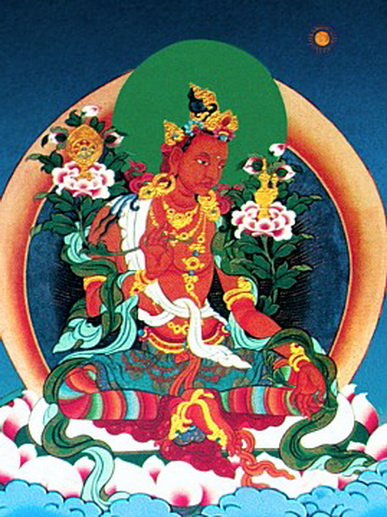Maitreya
Maitreya (Sanskrit), Metteyya (Pāli), or Jampa (Tibetan), is foretold as a future Buddha of this World in Buddhist eschatology.
In some Buddhist literature, such as the Amitabha Sutra and the Lotus Sutra, he or she is referred to as Ajita Bodhisattva.
Maitreya is a bodhisattva who in the Buddhist tradition is to appear on Earth, achieve complete enlightenment, and teach the pure dharma.
According to scriptures, Maitreya will be a successor of the historic Śākyamuni Buddha.
The prophecy of the arrival of Maitreya references a time when the Dharma will have been forgotten on Jambudvipa.
It is found in the canonical literatur of all Buddhist sects (Theravāda, Mahāyāna, Vajrayāna), and is accepted by most Buddhists as a statement about an event that will take place when the Dharma will have been forgotten on Earth.
Origins
The name Maitreya (Metteyya in Pāli) is derived from the Sanskrit word maitrī (Pāli:
mettā) meaning "Loving-kindness", which is in turn derived from the noun mitra (Pāli:
mitta) in the sense of "friend".
The earliest mention of Metteyya is in the Cakavatti Sutta (Sihanada)in the Digha Nikaya 26 of the Pali Canon. He occurs in no other Sutta in the Pali Canon, and this casts Doubt as to the Sutta's authenticity.
Most of The Buddha's sermons are presented as preached in answer to a question, or in some other appropriate context, but this one has a beginning and an ending in which The Buddha is talking to Monks about something totally different.
This leads Gombrich to conclude that either whole Sutta is apocryphal, or it has at least been tampered with.
Maitreya is sometimes represented seated on a throne Western-style, and venerated both in Mahāyāna and non-Mahāyāna Buddhism.
Some have speculated that inspiration for Maitreya may have come from the ancient Indo-Iranian deity Mithra.
The primary comparison between the two characters appears to be the similarity of their names.
According to a book entitled The Religion of the Iranian Peoples, "No one who has studied the Zoroastrian Doctrine of the Saoshyants or the coming saviour-prophets can fail to see their resemblance to the future Maitreya.
Paul Williams claims that some Zoroastrian ideas like Saoshyant influenced the beliefs about Maitreya, such as "expectations of a heavenly helper, the need to opt for positive righteousness, the future millennium, and universal salvation".
Possible objections are that these characteristics are not unique to Zoroastrianism, nor are they necessarily characteristic of the belief in Maitreya.
It is also possible that ([[[Maitreya]] Buddha originated with the Hindu Kalki, and that its similarities with the Iranian Mithra have to do with their common Indo-Iranian origin.
In the Greco-Buddhist Art of Gandhara, in the first centuries CE in northern India, Maitreya was the most popular figure to be represented, together with The Buddha Śākyamuni.
In China, in the 4th–6th Centuries "Buddhist artisans used the names Shakyamuni and Maitreya interchangeably... indicating both that the distinction between the two had not yet been drawn and that their respective iconographies had not yet been firmly set"
An example is the stone sculpture found in the Qingzhou cache dedicated to Maitreya in 529 CE as recorded in the inscription (currently in the Qingzhou Museum, Shandong).
The cult of Maitreya apparently developed around the same time of that of Amitābha, as early as the 3rd century CE.
Characteristics
One mention of the prophecy of Maitreya is in the Sanskrit text, the Maitreyavyākaraṇa (The Prophecy of Maitreya).
It implies that he is a teacher of Meditative trance sadhana and states that gods, men and other beings:
- will lose their doubts, and the torrents of their cravings will be cut off: free from all misery they will manage to cross the ocean of becoming; and, as a result of Maitreya's teachings, they will lead a holy Life.
No longer will they regard anything as their own, they will have no possession, no gold or silver, no home, no relatives! But they will lead the holy Life of oneness under Maitreya's guidance.
They will have torn the net of the passions, they will manage to enter into trances, and theirs will be an abundance of Joy and Happiness, for they will lead a holy Life under Maitreya's guidance. (Trans. in Conze 1959:241)
General description
Maitreya is typically pictured seated, with either both feet on the ground or crossed at the ankles, on a throne, waiting for his time.
He is dressed in the Clothes of either a Bhiksu or Indian royalty.
As a bodhisattva, he would usually be standing and dressed in jewels.
Usually he wears a small Stupa in his headdress that represents the Stupa of The Buddha Sakyamuni's relics to help him identify it when his turn comes to lay claim to his succession, and can be holding a dharmachakra resting on a Lotus.
A khata is always tied around his waist as a girdle.
In the Greco-Buddhist Art of Gandhara, in the first centuries CE in northern India, Maitreya is represented as a [[Wikipedia:Central Asian|Central Asian]] or northern Indian nobleman, holding a "water phial" (Sanskrit:
Kumbha) in his left hand. Sometimes this is a "Wisdom urn" (Sanskrit: Bumpa). He is flanked by his two acolytes, the brothers Asanga and Vasubandhu.
Maitreya's Tuṣita Heaven
Maitreya currently resides in the Tuṣita Heaven (Pāli: Tusita), said to be reachable through Meditation.
Śākyamuni Buddha also lived here before he was born into the World as all Bodhisattvas live in the Tuṣita Heaven before they descend to the Human realm to become Buddhas.
Although all Bodhisattvas are destined to become Buddhas, the concept of a bodhisattva differs greatly in Theravada and Mahayana Buddhism.
In Theravada Buddhism, a bodhisattva is one who is striving for full enlightenment (Arahantship in Pali), whereas in Mahayana Buddhism, a bodhisattva is one who has already reached a very advanced state of grace or enlightenment but holds back from entering Nirvana so that he may help others.
In Mahayana Buddhism, once Maitreya becomes a Buddha, he will rule over the Ketumati Pure land, an earthly paradise sometimes associated with the Indian city of Varanasi (also known as Benares) in Uttar Pradesh.
In Mahayana Buddhism, Buddhas preside over a Pure land (The Buddha Amitabha presides over the Sukhavati Pure land, more popularly known as The Western Paradise).
In Theravadin Buddhism, Buddhas are born as unenlightened humans, and are not rulers of any paradise or Pure land. Maitreya's arising would be no different to the arising of Shakyamuni Buddha, as he achieved full-enlightenment as a human being, and passed away into parinibbana when the conditions were ripe for his final passing.
Orthodox Theravadin Doctrine has much less emphasis on deities and Bodhisattvas, and do not view Bodhisattvas as Enlightened beings.
Activity of Maitreya in the current age
- See also: Maitreya-nātha
In Mahayana schools, Maitreya is traditionally said to have revealed the Five Treatises of Maitreya through Asanga.
These important texts are the basis of the Yogachara tradition and constitute the majority of the Third Turning of the Wheel of Dharma.
Future coming of Maitreya
According to tradition, Maitreya will be the fifth Buddha of the present kalpa (aeon) and his arrival will occur after the teachings (dharma) of the current Gautama Buddha are less meaningfully communicated.
Maitreya's coming is characterized by a number of physical events.
For example, the oceans are predicted to decrease in size, allowing Maitreya to traverse them freely.
These events will also enable the reintroduction of the "true" dharma to the people, in turn allowing the construction of a new World.
His arrival signifies the end of the middle time, the time between fourth Buddha, Gautama Buddha, and the fifth Buddha, Maitreya, which is viewed as a low point of human existence.
According to the Cakkavatti Sutta:
The Wheel-turning Emperor, Digha Nikaya 26 of the Sutta Pitaka of the Pāli Canon), Maitreya Buddha will be born in a time when humans will live to an age of eighty thousand years, in the city of Ketumatī (present Benares), whose king will be the Cakkavattī Sankha.
Sankha will live in the palace where once dwelt King Mahāpanadā, but later he will give the palace away and will himself become a follower of Maitreya Buddha.
The scriptures say that Maitreya will attain bodhi in seven days (which is the minimum period), by Virtue of his many lives of preparation for Buddhahood (similar to those reported in the Jataka stories of Shakyamuni Buddha).
At this time a notable teaching he will start giving is that of the ten non-virtuous deeds
(killing, stealing, sexual misconduct, lying, divisive speech, abusive speech, idle speech, covetousness, harmful intent and wrong views)
and the ten virtuous deeds (the abandonment of:
killing,
stealing,
sexual misconduct,
lying,
divisive speech,
abusive speech,
idle speech,
covetousness,
harmful intent and
wrong views).
The Arya Maitreya Mandala, founded by Lama Anagarika Govinda is based on the idea of the future coming of Maitreya.
Buddhist views opposing the concept of future Buddha
According to the Buddhism of the Lotus Sutra, each person possesses the "Buddha nature", which can be revealed in this lifetime.
The concept of inherent "Buddha nature" in each person does not fit well with the concept of a Future Buddha descending from Heaven because each person can become a Buddha.
The Doctrine of inherent Buddha nature makes each person a future Buddha in one's lifetime.
Nichiren Buddhism emphasises on "Attaining Buddhahood in this Lifetime", as Buddhahood is attainable through the practice of the Lotus Sutra.
Maitreya appears as a significant figure in the text of the Lotus Sutra, however, Nichiren's explanation of Maitreya was as just a metaphor indicating a protective force and a function of “guarding and helping” the Bodhisattvas of the Earth, who also appear in the Lotus Sutra:
“Moreover... all the Bodhisattvas, Bodhisattva Maitreya ... will guard and protect the votaries of the Lotus Sutra, so one may indeed rest assured”.
In many of his Writing, Nichiren mentions the traditional Buddhist views on Maitreya - but clearly explains that the propagation of the Eternal Dharma of the Lotus Sutra was entrusted by Shakyamuni to the “Earth Bodhisattvas”: “
The Buddha did not entrust these five characters to Maitreya, Medicine King, or the others of their group.
Instead he summoned forth the Bodhisattvas....from the great earth of Tranquil Light and transferred the five characters to them”.
In view of Nichiren Buddhism, each person embodies the character of “the Maitreya” because Maitreya is a metaphor for the function of Compassion :
“The name Maitreya means ‘Compassionate One’ and designates the Votaries of the Lotus Sutra”.
Non-Buddhist views
The concept of Maitreya was elaborated within Theosophy during the last few decades of the 19th century. However the Theosophical Maitreya was explained, and developed, differently than the original Buddhist concept.
In Theosophical texts Maitreya has multiple aspects signifying not just the future Buddha, but similar concepts from other religious or Spiritual traditions.
In early 20th century, leading Theosophists became convinced that an appearance of the Maitreya as a so-called World Teacher was imminent.
A South Indian boy, Jiddu Krishnamurti, was Thought to be destined as the "vehicle" of the soon-to-manifest Maitreya;
however the manifestation did not happen as predicted, and did not fulfill Theosophists' expectations.
Since the growth of the Theosophical movement in the 19th century, and influenced by Theosophy's articulations on the Maitreya, non-Buddhist religious and Spiritual movements have adopted and reinterpreted the concept in their doctrines.
Share International, which equates Maitreya with the prophesied figures of multiple religious traditions, claims that he is already present in the World, but is preparing to make an open declaration of his presence in the near future.
They claim that he is here to inspire mankind to create a new era based on sharing and justice.
In the beginning of the 1930s, the Ascended Master Teachings placed Maitreya in the "Office of World Teacher" until 1956, when he was described as moving on to the "Office of Planetary Buddha" and "Cosmic Christ" in their concept of a Spiritual Hierarchy.
Some Muslim scholars who studied Buddhist texts believe that Maitreya is "Rahmatu lil-'alameen" (Mercy for The Worlds), which is the name for the prophet Muhammad as it is said in the Qur'an.
According to the research on the book Antim Buddha - Maitreya scholars have surmised that Maitreya Buddha is Muhammad.
After examining the Buddhist texts researchers concluded that Muhammad had been the last and final Awakened Buddha to come into existence long after the current teachings.
The 19th century, Mirza Ghulam Ahmad, is believed in by the members of the Ahmadiyya Community (the Faith he brought) as fulfilling expectations regarding the Maitreya Buddha.
Bahá'ís believe that Bahá'u'lláh is the fulfillment of the prophecy of appearance of Maitreya.
Bahá'ís believe that the prophecy that Maitreya will usher in a new society of tolerance and Love has been fulfilled by Bahá'u'lláh's teachings on World peace.
Maitreya claimants
- See also: List of Buddha claimants

Since his Death, the Chinese monk Budai (Hotei) has been popularly regarded as an incarnation of the bodhisattva Maitreya. His depiction as the Laughing Buddha continues to be very popular in East Asian culture.
While a number of persons have proclaimed themselves to be Maitreya over the years following The Buddha’s Parinirvana, none have been officially recognized by The Sangha and Buddhists.
A particular difficulty faced by any would-be claimant to Maitreya's title is the fact that The Buddha is considered to have made a number of fairly specific predictions regarding the circumstances that would occur prior to Maitreya's coming; such as that the teachings of The Buddha would be completely forgotten, and all of the remaining relics of Sakyamuni Buddha would be gathered in Bodh Gaya and cremated.
The following list is just a small selection of those people who claimed or claim to be the incarnation of Maitreya.
Many have either used the Maitreya incarnation claim to Form a new Buddhist sect or have used the name of Maitreya to Form a new religious movement or cult.
- Gung Ye, a Korean warlord and king of short-lived state of Taebong during the 10th century, claimed himself as living incarnation of Maitreya and ordered his subjects to worship him.
His claim was widely rejected by most Buddhist Monks and later he was dethroned and killed by his own servants.
- In 613 the monk Xiang Haiming claimed himself Maitreya and adopted imperial title.
- In 690 Empress Wu inaugurated the Second Zhou dynasty, proclaimed herself an incarnation of the future Buddha Maitreya, and made Luoyang the "holy capital."
In 693 she replaced the compulsory Dao De Jing in the curriculum temporarily with her own Rules for Officials.
- Lu Zhong Yi, the 17th Patriarch of I-Kuan Tao, claimed to be an incarnation of Maitreya.
- l. Ron Hubbard, founder of the belief systems Dianetics and Scientology, suggested he was "Metteya" (Maitreya) in the 1955 poem Hymn of Asia.
Numerous editors and followers of Hubbard claim that in the book's preface, specific physical characteristics said to be outlined—in unnamed Sanskrit sources—as properties of the coming Maitreya;
properties which Hubbard's appearance supposedly aligned with.
"an All-Surpassing God-Man yet to come -- a final Avatar, the ultimate Messiah, a consumate Prophet or Enlightened Sage, a Spiritual Deliverer who will appear in the 'late-time', the 'dark' epoch when humanity is lost, apparently cut off from Wisdom, Truth and God.
Buddhists call that Expected One 'Maitreya'."
- Raël's Maitreya claims center on the content of the Agama Sutra (Japanese: Agon Sutra), supposedly a very ancient text written by Buddha himself, but which has been deemphasized or forgotten by the majority of Buddhist cultures.
Raël has claimed directly to people attending Asia Raëlian Church seminars, that someone born in France, a country which is often symbolized by the cock (or rooster), west of the Orient, meets the criteria of the Maitreya.
Rael himself claims to be this individual.
- Joseph Emmanuel of the Mission of Maitreya claims to be the ([[[Maitreya]] Buddha)], as well as a major prophet of God who purportedly fulfills prophecies from the Old Testament, New Testament, Qur'an, Baha'i scriptures and eastern scriptures.
Perhaps the most prominent example of Emmanuel's claims to being the Maitreya is the fact that his main teaching seeks to unify the World's religions by means of showing how each Religion corresponds to one of seven "seals".
His use of the term "seal" is a reference to a central tenet of Christian eschatological belief described in the Bible, in which it is predicted that Christ would return and open a book sealed with "seven seals" (Rev 5:5).
The Mission of Maitreya also makes claims that link Emmanuel's teaching of seven seals to Buddhist tradition.
According to Buddhist Scriptures, the Maitreya Buddha will "take seven steps forward, and where he puts down his feet a jewel or Lotus will spring up."
Emmanuel was originally a student of the yoga teacher P.R. Sarkar in India, who founded Ananda Marga, and while in this organization, Emmanuel was given the Spiritual name "Maitreya."
This has been cited as further evidence by the Mission of Maitreya that Joseph Emmanuel is the true Maitreya.
Maitreya sects in China
Pre-Maitreyan Buddhist messianic rebellions
Southern and Northern Dynasties
- 515: The Mahayana Rebellion.
In the late summer of that year, the renegade monk Faqing 法慶 married a nun and formed a sect in the Northern Wei province of Jizhou 冀州 (in the southern part of today’s Hebei province) with the assistance of a local aristocrat named Li Guibo 李歸伯.
The sect was named the Mahayana ("The Great Vehicle", in reference to Mahayana Buddhism), and Li Guibo was given the titles of Tenth-stage Bodhisattva, Commander of the Demon-vanquishing Army, and King who Pacifies the Land of Han by Faqing.
- Using Drugs to send its members into a killing frenzy, and promoting them to Tenth-Stage Bodhisattva as soon as they killed ten enemies, the Mahayana sect seized a prefecture and murdered all the government officials in it.
Their slogan was "A new Buddha has entered the World; eradicate the demons of the former age", and they would kill all Monks and nuns in the Monasteries that they captured, also burning all the Sutras and icons.
After defeating a government army and growing to a size of over 50,000, the rebel army was finally crushed by another government army of 100,000. Faqing, his wife, and tens of thousands of his followers were beheaded, and Li Guibo was also captured later and publicly executed in the capital city Luoyang.
- The Fozu Tongji (Comprehensive Records of The Buddha), a chronicle of Buddhist history written by the monk Zhipan in 1269, also contains an account of the Mahayana Rebellion, but with significant deviations from the original account, such as dating the rebellion to 528 rather than 515.
- 516: The Moonlight Child Rebellion.
Toward the end of that year, another sect was discovered by local authorities in Yanling (a county or prefecture of Jizhou).
A man named Fa Quan and his associates were claiming that an eight-year-old child named Liu Jinghui was a Bodhisattva called the Moonlight Child (yueguang tongzi pusa; 月光童子菩萨), and that he could transform into a snake or a pheasant.
They were arrested and sentenced to Death on suspicion of seditious intent, but Jinghui had his sentence commuted to banishment on account of his youth and Ignorance.
- 517: Early in the spring of that year, surviving remnants of the Mahayana rebels regrouped and mounted a sudden attack on the capital of Yingzhou province, which lay just northwest of their original base in Bohai prefecture.
They were repelled only after a pitched battle with an army of slaves and attendants led by Yuwen Yan, the son of the provincial governor, and nothing more is known of their Fate.
Although a "new Buddha" was mentioned, these rebellions are not considered "Maitreyan" by modern scholars. However, they would be a later influence on the rebel religious leaders that made such claims.
Therefore, it is important to mention these rebellions in this context.
Maitreyan rebellions
Sui Dynasty
- 610: On the first day of the Chinese New Year, dozens of rebels dressed in white, burning Incense and holding Flowers proclaimed their leader as Maitreya Buddha and charged into the imperial palace through one of its gates, killing all the guards before they were themselves killed by troops led by an imperial prince.
A massive Investigation in the capital (Chang'an) implicated over a thousand families.
- 613: A skilled magician named Song Zixian claimed to be Maitreya in Tang County (northwest of Yingzhou), and allegedly could transform into the Form of a Buddha and make his room emit a glow every night.
He hung a mirror in a hall that could display an image of what a devotee would be reincarnated as – a snake, a beast or a human being.
Nearly a thousand "from near and far" joined his sect every day, and he plotted to first hold a Buddhist vegetarian banquet (wuzhe fohui) and then make an attack on the emperor who was then touring Yingzhou.
The plot was leaked out, and Song was arrested and executed with over a thousand families of his followers.
- 613: The monk Xiang Haiming claimed to be Maitreya in Fufeng prefecture (western Shaanxi) and led a rebellion.
The elite of the Chang’an area hailed him as a holy man (dasheng) because they had auspicious Dreams after following him, and his army swelled to several tens of thousands before he was defeated by government troops.
Tang Dynasty
- 710: Wang Huaigu declared, "The Shakyamuni Buddha has declined; a new Buddha is about to appear.
The House of Li is ending, and the House of Liu is about to rise".
Song Dynasty
- 1047: Army officer Wang Ze led a revolt of Buddhists expecting Maitreya; they took over the city of Beizhou in Hebei before they were crushed.
The Song Dynasty government declared Maitreya Sects to be "heresies and unsanctioned religions". Tens of thousands of Maitreya Sect followers were killed.
Yuan and Ming Dynasty
- 1351: The Red Turban Rebellion (a.ka. The First White Lotus Rebellion).
Han Shantong (韓山童), leader of the White Lotus Society, and Army Commander Liu Futong (劉福通) rebelled against the Mongol masters of the Yuan Dynasty.
Shantong's anti-Mongol slogan was "The empire is in utter chaos.
Maitreya Buddha has incarnated, and the Manichaean King of Light has appeared in this World."
- In 1355, Han Shantong's son, Han Lin'er (韓林兒), was proclaimed "Emperor of the Great Latter Song" (大宋, referring to the dead Song Dynasty) (1355-1368?) by Liu Futong.
Liu Futong claimed Han Lin'er was a direct descendent of the Zhao royal family who ruled the Song Dynasty.
After Liu Futong's Death, Zhu Yuanzhang took up command of the Red Turban Rebellion and later assassinated Han Lin'er to become Emperor Hongwu of the Ming Dynasty.
- According to Beijing University,
- “The leader of White Lotus sect, Han Shantong called himself Ming Wang (明王 - "King of Brightness"), while his son, Han Lin'er called himself Xiao Ming Wang (小明王 - "Small King of Brightness"), both names reflecting the sect's beliefs.
Zhu Yuanzhang had been a member of the White Lotus Sect, and admitted to have been a branch of the White Lotus rebel army (being at one time vice-marshal of Xiao Ming Wang).
When Zhu Yuanzhang took Power, he chose the dynastic name "Ming".”
This suggests that the Ming Dynasty was named after the White Lotus figures of the "Big and Little Bright Kings".
Post-Maitreyan rebellions
[[File:Maitreya_and_disciples_carving_in_Feilai_Feng_Caves.jpg|thumb|right|Maitreya and disciples, in Budai form, as depicted at the Feilai Feng grottos near Lingyin Temple in China)]
Qing Dynasty
- 1796: The White Lotus Rebellion (a.k.a. The Second White Lotus Rebellion).
It broke out among impoverished settlers in the mountainous region that separates Sichuan province from Hubei and Shaanxi provinces.
It apparently began as a White Lotus Society protest against heavy taxes imposed by Manchu rulers of the Qing Dynasty.
- The Yi He Tuan (義和團), often called in English the "Society of Harmonious Fists" was a 19th century martial-sect inspired in part by the White Lotus Society.
Members of the "Harmonious Fists" became known as "Boxers" in the west because they practiced Chinese martial arts.
- 1899: The Boxer Rebellion (義和團之亂). It was a Chinese rebellion from November 1899 to September 7, 1901 against foreign influence in such areas as trade, politics, Religion and technology that occurred in China during the final years of the Qing Dynasty.
By August 1900, over 230 foreigners, tens of thousands of Chinese Christians, an unknown number of rebels, their sympathizers and other innocent bystanders had been killed in the ensuing chaos.
The uprising crumbled on August 14, 1900 when 20,000 foreign troops entered the Chinese capital, Peking (Beijing).
Albeit not in the name of Maitreya, both rebellions were perpetrated solely or in part by the White Lotus Society, a rebellious Maitreya sect.
Alternative persona
There was a sage of the same name in the epic Mahabharata. His lineage is unknown.
He came to the court of Hastinapura to advise Duryodhana to restore the kingdom of the Pandavas, a little while after the sons of Pandu had gone into exile, having been defeated at dice.
However, Duryodhana didn't even bother to listen to the sage, and showed his disrespect all too plainly.
Incensed, the sage cursed him and said, "Fourteen years hence, you shall be destroyed in battle by the Pandavas, along with your kinsmen and all that you hold dear.
Bheema shall dispatch you to the abode of Yama, by breaking your thighs with the mace."
Some hold that the curse of this sage played a major part in encompassing the destruction of the Kauravas.
Source
Maitreya (Skt.; Tib. བྱམས་པ་, Jampa; Wyl. byams pa) or Maitreyanatha (Skt. Maitreynātha; Tib. Jampé Gönpo; Tib. བྱམས་པ་མགོན་པོ་, Wyl. byams pa'i mgon po) is the bodhisattva who will be the next buddha after Shakyamuni Buddha.
For now he resides in Tushita. He transmitted teachings to Asanga, who transcribed them as the ‘Five Treatises of Maitreya’.
As one of the eight great bodhisattvas, he is sometimes depicted as whitish-yellow in colour and holding an orange bush which dispels the fever of the destructive emotions.
Five Treatises
Maitreya transmitted the root teachings to Asanga.
Among the five, four are classed as shastras (commentaries) proper, and one falls into the class of oral instructions.
The four that are shastras are extensive are:
- The Ornament of Clear Realization (Skt. Abhisamayālaṃkāra; Tib. མངོན་རྟོགས་པའི་རྒྱན་, Wyl. mngon par rtogs pa'i rgyan).
- The Ornament of the Mahayana Sutras (Skt. Māhayānasūtrālaṃkāra; Tib. ཐེག་པ་ཆེན་པོའི་མདོ་སྡེ་རྒྱན་, theg pa chen po'i mdo sde rgyan).
- Distinguishing the Middle from the Extremes (Skt. Madhyāntavibhāga; Tib. དབུས་དང་མཐའ་རྣམ་པར་འབྱེད་པ་, dbus dang mtha' rnam par 'byed pa).
- Distinguishing Dharma and Dharmata (Skt. Dharma-dharmatā-vibhāga; Tib. ཆོས་དང་ཆོས་ཉིད་, chos dang chos nyid rnam par 'byed pa) is very brief and direct in its presentation and is included within the class of oral instructions.
- The Sublime Continuum (Skt. Uttaratantra Śāstra; Tib. རྒྱུད་བླ་མ་, Wyl. rgyud bla ma).
Further Reading
- The Fortunate Aeon: How the Thousand Buddhas Became Enlightened (Berkeley: Dharma Publishing, 1986), volume 2, page 521-523.
- Jamgön Mipham, A Garland of Jewels, (trans. by Lama Yeshe Gyamtso), Woodstock: KTD Publications, 2008
- Sogyal Rinpoche, The Tibetan Book of Living and Dying, pages 125-126.
External Links
Source
Maitreya (Skt)
弥勒菩薩 ( Jpn Miroku-bosatsu)
(1) A bodhisattva predicted to succeed Shakyamuni as a future Buddha.
Also known as Ajita, meaning invincible. In China, Maitreya was rendered as Compassionate One or Compassionate Honored One.
The Sanskrit word maitreya means friendly, benevolent, affectionate, or amicable.
He is said to have been reborn in the Tushita Heaven and to reside in the inner court of this heaven, where he now teaches the heavenly beings.
According to the Advent of Maitreya Sutra, he is to reappear in the world 5,670 million years after Shakyamuni's death, attain Buddhahood, and save the people in Shakyamuni's stead.
For this reason, he is also sometimes called Maitreya Buddha. Belief in Maitreya prevailed in India around the beginning of the first century and spread to China and Japan.
The founder of the Consciousness-Only school, thought to have been the teacher of Asanga and to have lived around 270-350 (350-430 according to another account).
Various ancient works of India, China, and Tibet mention that Asanga ascended to the Tushita Heaven where he learned the Mahayana doctrines from Bodhisattva Maitreya and thereby attained enlightenment.
Nevertheless, scholars have come to identify Asanga's teacher with a historical personage named Maitreya.
Asanga is thought to have inherited Maitreya's teachings and advanced the systematization of the Consciousness-Only doctrine.
Maitreya's works include The Treatise on the Stages of Yoga Practice, The Treatise on the Discrimination of the Middle and the Extreme, and The Ornament of Mahayana Sutras.
Source
Maitreya is 'The Buddha of the future'.
He is currently giving teachings to the heavenly beings at his residence in the Tusita Heaven and waiting for his time to take the place of Sakyamuni as The Buddha of the fifth World cycle.
In the future Maitreya will be like Sakyamuni, a great savior and re-newer to establish on earth a new era and guide the mankind to the Path of Buddha.
Maitreya, 'the offer Joy one' is an important and popular deity who is widely worshipped in the Himalayan and East Asian regions. Because he is also frequently alluded to in Pali exegetical literature, Maitreya is hence the only Bodhisattva recognized throughout Theravadin and Mahayana.
As predicted by Shakyamuni Buddha, due to the inevitable cycle of Samsara (The Wheel of Life) his teachings would last fifteen thousand years before disappearing from this World.
People's immorality, after that, will gradually increase.
As the Merit of Life decrease their Life-span and Fortune will thus degenerated, the World will result in a vast battlefield of graveyard.
After 5670000000 years, as the cycle of lifespan changing from decrease to increase, people's health and Spiritual quality will gain positive improvement.
As the human lifespan increased again to 80 thousands of years, the World will be entirely dominated by a benevolent Wheel-turning sovereign named Shankha.
The World in this time will be politically neutralized, and therefore the warrior class and its martial virtues will be obsolete. People will be living in a prosperous society with peaceful and joyful environment.
That is the time when Maitreya Buddha will descend from the Tushita Heaven to this World. Maitreya will be born the son of a priest, and will renounce the World and attain Enlightenment in a single day, unlike Shakyamuni's six-year of practice. Due to the high intellect of the audience, Maitreya will only offer three Dharma lectures to the public. T
he principle of his teachings will not deviate from any previous Buddhas' Dharma, except for the emphasis in the perfection of Liberation techniques.
Unlike Shakyamuni's asceticism, Maitreya's followers will not have any material and Spiritual obstacle; this new teachings will offer Joy and Happiness to interpret Dharma for the ultimate Enlightenment.
Shakyamuni Buddha has predicted that those who followed Maitreya's teachings would be reborn in the Tusita Heaven and would be able to complete the Spiritual Path under Maitreya's guidance.
A Chinese Monk called Shi-Ts (?-916) was believed as an emanation of Maitreya (called Mi-Lo-Fo).
His laughing figure with a fat belly uniquely represents Maitreya in China and has been commonly adopted by Vietnamese (called Di-Lac), Korean and Japanese (called Miroku) Buddhist since.
This localized transformation is one of the most popular Buddhist figures in East Asia.
Source
Maitreya. (P. Metteya; T. Byams pa; C. Mile; J. Miroku; K. Mirŭk 彌勒).
In Sanskrit, “The Benevolent One”; the name of the next buddha, who now abides in Tuṣita heaven as a Bodhisattva, awaiting the proper time for him to take his final rebirth.
Buddhists believed that their religion, like all conditioned things, was inevitably impermanent and would eventually vanish from the earth (cf. Saddharmavipralopa; Mofa).
According to one such calculation, the teachings of the current buddha Śākyamuni would flourish for five hundred years after his death, after which would follow a one thousand- year period of decline and a three-thousand-year period in which the dharma would be completely forgotten.
At the conclusion of this long disappearance, Maitreya would then take his final birth in India (Jambudvīpa) in order to reestablish the Buddhist dispensation anew.
According to later calculations, Maitreya will not take rebirth for some time, far longer than the 4,500 years mentioned earlier.
He will do so only after the human life span has decreased to ten years and then increased to eighty thousand years.
(Stalwart scholiasts have calculated that his rebirth will occur 5.67 billion years after the death of Śākyamuni.)
Initially a minor figure in early Indian Buddhism, Maitreya (whose name derives from the Indic Maitrī, meaning “loving-kindness” or “benevolence”) evolved during the early centuries of the Common Era into one of the most popular figures in Buddhism across Asia in both the mainstream and Mahāyāna traditions.
He is also known as Ajita, although there are indications that, at some point in history, the two were understood to be different deities.
As the first bodhisattva to become a figure of worship, his imagery and cult set standards for the development of later bodhisattvas who became objects of cultic worship, such as Avalokiteśvara and Mañjuśrī.
Worship of Maitreya began early in Indian Buddhism and became especially popular in Central and East Asia during the fifth and sixth centuries.
Such worship takes several forms, with disciples praying to either meet him when he is reborn on earth or in tuṣita heaven so that they may then take rebirth with him when he becomes a buddha, a destiny promised in the Saddharmapuṇḍarīkasūtra (“Lotus Sūtra”) to those who recite his name.
Maitreya is also said to appear on earth, such as in a scene in the Chinese pilgrim Xuanzang’s account of his seventh-century travels to India: attacked by pirates as he sailed on the Ganges River, Xuanzang prayed to and was rescued by the bodhisattva.
Maitreya also famously appeared to the great Indian commentator Asaṅga in the form of a wounded dog as a means of teaching him the importance of compassion.
Devotees across the Buddhist world also attempt to extend their life span in order to be alive when Maitreya comes, or to be reborn at the time of his presence in the world, a worldly paradise that will be known as ketumati.
His earliest iconography depicts him standing or sitting, holding a vase (Kuṇḍikā), symbolizing his imminent birth into the brāhmaṇa caste, and displaying the Abhayamudrā, both features that remain common attributes of his images.
In addition, he frequently has a small Stūpa in his headdress, believed to represent a prophecy regarding his descent to earth to receive the robes of his predecessor from Mahākāśyapa.
Maitreya is also commonly depicted as a buddha, often shown sitting in “European pose” (Bhadrāsana; see also Maitreyāsana), displaying the Dharmacakramudrā.
He is said to sit in a chair in “pensive” posture in order to be able to quickly stand and descend to earth at the appropriate time. Once he is reborn, Maitreya will replicate the deeds of Śākyamuni, with certain variations.
For example, he will live the life of a householder for eight thousand years, but having seen the four sights (Caturnimitta) and renounced the world, he will practice asceticism for only one week before achieving buddhahood.
As the Buddha, he will first travel to Mount Kukkuṭapāda near Bodhgayā where the great Arhat Mahākāśyapa has been entombed in a state of deep Samādhi, awaiting the advent of Maitreya.
Mahākāśyapa has kept the robes of Śākyamuni, which the previous buddha had entrusted to him to pass on to his successor. Upon his arrival, the mountain will break open, and Mahākāśyapa will come forth from a stūpa and give Maitreya his robes.
When Maitreya accepts the robes, it will only cover two fingers of his hands, causing people to comment at how diminutive the past buddha must have been.
The cult of Maitreya entered East Asia with the initial propagation of Buddhism and reached widespread popularity starting in the fourth century CE, a result of the popularity of the Saddharmapuṇḍarīkasūtra and several other early translations of Maitreya scriptures made in the fourth and fifth centuries.
The Saddharmapuṇḍarīkasūtra describes Maitreya’s present abode in the tuṣita heaven, while other sūtras discuss his future rebirth on earth and his present residence in heaven.
Three important texts belonging to the latter category were translated into Chinese, starting in the fifth century, with two differing emphases:
- (1) the Guan Mile pusa shangsheng doushuo tian jing promised sentient beings the prospect of rebirth in tuṣita heaven together with Maitreya; and
- (2) the Guan Mile pusa xiasheng jing and
- (3) the Foshuo Mile da chengfo jing emphasized the rebirth of Maitreya in this world, where he will attain buddhahood under the Dragon Flower Tree (Nāgapuṣpa) and save numerous sentient beings.
These three texts constituted the three principal scriptures of the Maitreya cult in East Asia.
In China, Maitreya worship became popular from at least the fourth century:
Dao’an (312–385) and his followers were among the first to propagate the cult of Maitreya and the prospect of rebirth in tuṣita heaven.
With the growing popularity of Maitreya, millenarian movements associated with his cult periodically developed in East Asia, which had both devotional and political dimensions.
For example, when the Empress Wu Zetian usurped the Tang-dynasty throne in 690, her followers attempted to justify the coup by referring to her as Maitreya being reborn on earth.
In Korea, Maitreya worship was already popular by the sixth century.
The Paekche king Mu (r. 600–641) identified his realm as the world in which Maitreya would be reborn.
In Silla, the hwarang, an elite group of male youths, was often identified with Maitreya and such eminent Silla monks as Wŏnhyo (617–686), Wŏnch’ŭk (613–696), and Kyŏnghŭng (fl. seventh century) composed commentaries on the Maitreya scriptures.
Paekche monks transmitted Maitreya worship to Japan in the sixth century, where it became especially popular in the late eighth century.
The worship of Maitreya in Japan regained popularity around the eleventh century, but gradually was replaced by devotions to Amitābha and Kṣitigarbha.
The worship of Maitreya has continued to exist to the present day in both Korea and Japan.
The Maitreya cult was influential in the twentieth century, for example, in the establishment of the Korean new religions of Chŭngsan kyo and Yonghwa kyo.
Maitreya also merged in China and Japan with a popular indigenous figure, Budai (d. 916)—a monk known for his fat belly—whence he acquired his now popular East Asian form of the “laughing Buddha.”
This Chinese holy man is said to have been an incarnation of the bodhisattva Maitreya (J.
Miroku Bosatsu) and is included among the Japanese indigenous pantheon known as the “seven gods of good fortune”(Shichifukujin).
Hotei represents contentment and happiness and is often depicted holding a large cloth bag (Hotei literally means “hemp sack”).
From this bag, which never empties, he feeds the poor and needy.
In some places, he has also become the patron saint of restaurants and bars, since those who drink and eat well are said to be influenced by Hotei.
Today, nearly all Chinese Buddhist monasteries (and many restaurants as well) will have an image of this Maitreya at the front entrance; folk belief has it that by rubbing his belly one can establish the potential for wealth.
Source
The Princeton Dictionary of Buddhism by Robert E. Buswell Jr. and Donald S. Lopez Jr.
Sanskrit word, literally means friendly and benevolent. He will be the next Buddha in our world. He is now preaching in Tusita Heaven. In China, he is usually represented as the fat laughing Buddha.
The buddha who is expected to come in the future, known to all schools of Buddhism.
He is worshipped as a being who guides those who confess their wrongs, and teachers who become discouraged.
He is sometimes depicted as the "Laughing Buddha" with his hands stretched over his head, a smile on his face, and a large, bare stomach.
He represents all encompassing love.
The future Buddha, or the Buddha of the next world age.
He is commonly represented sitting on a raised seat with his feet resting on the ground as a sign to arise from his seat and appear in the world.
Sanskrit word, literally means friendly and benevolent.
He will be the next Buddha in our world.
He is now preaching in Tusita Heaven.
He is usually represented as the fat laughing Buddha.
The Buddha who is expected to come in the future, known to all schools of Buddhism.
He is worshipped as a being who guides those who confess their wrongs, and teachers who become discouraged.
He is sometimes depicted as the "Laughing Buddha" with his hands stretched over his head, a smile on his face, and a large, bare stomach.
One who has the nature of loving kindness. Name of the future Buddha.
The Buddha of the Future.
Maitreya (Chinese: Mi lo; Japanese: Miroku), the Buddha of the Future, believed to reside in the Tushita Heaven until it is time for him to succeed Shakyamuni as the next incarnation of Buddhahood on earth.
According to some Buddhist traditions, the period of the Buddhist Law is divided into three stages: a first period of 500 years is of the turning of the Wheel of the Law; a second period of 1,000 years is of the deterioration of the Law, and the third period of 3,000 years is the one during which no one practices the Law.
After this, Buddhism having disappeared, a new Buddha will appear who will again turn the Wheel of the Law.
This future Buddha known as Maitreya is beloved to be still in the Tushita heaven, in the state of a bodhisattva.
It is believed that Gautama Buddha himself enthroned him as his successor.
The word maitreya is derived from the Sanskrit word for friendliness.
Thus this bodhisattva is fundamentally said to embody the qualities of amiability and an attitude of well meaning sympathy.
According to a legend there once descended to the earth from Maitreyas Tushita heaven a Chinese layman and teacher named Mahasattva Fu, widely regarded as an incarnation of Maitreya.
Fu attracted many students to his Dharma lectures. Living in a time of great hardships and famines for the peasants, he sold all of his possessions to feed the local villagers, and also fasted to give away his food to the needy.
Fu once undertook a long hunger fast to protest against the kings treatment of the poor.
He announced that he would finish the fast with a fiery self immolation, as an offering to benefit all suffering beings.
At the culmination of his fast, many of his followers offered to burn themselves in his place, some going to the extent of burning their fingers or cutting off their ears as offerings and engaging in other ascetic extremes.
They finally convinced Fu to abandon his plan.
The notion of a bodhisattva sacrificing his complete physical self or at least parts of it conforms to a similar notion expounded in ancient Buddhist texts.
For example the Shat sahasrika Prajna paramita (5th century AD) says:
"Besides wealth and material objects, a bodhisattva should be ready to sacrifice his limbs for the good of others, his hand, foot, eye, flesh, blood, marrow, limbs great and small, and even his head."
Indeed in the Jataka tales which are legendary stories about bodhisattvas, there abound numerous instances where they are shown sacrificing parts of their bodies or even their lives to save that of another.
A persistent paradox regarding Maitreya is his visualization as an entity of the future.
This presents a contrast to much of Buddhist practice and teaching which emphasizes the importance of the present, the current moment. This is sometimes referred to as the timeless eternal.
According to the Buddhist viewpoint time does not exist as some external container, but is the vital expression and enactment of our own being right now.
Time does not exist separate from our own presence.
As a bodhisattva associated with the future, as against the fundamental stress Buddhism places on the present moment of time,
The embodiment of the loving kindness of all the Buddhas. At the time of Buddha Shakyamuni he manifested as a Bodhisattva disciple in order to show Buddha,s disciples how to be perfect Mahayana disciples.
In the future, he will manifest as the fifth founding Buddha.
Maitreya or Metteyya (Pali) is a future Buddha of this world in Buddhist eschatology.
In some Buddhist literature, such as the Amitabha Sutra and the Lotus Sutra, he is referred to as Ajita Bodhisattva.
Maitreya is a bodhisattva who in the Buddhist tradition is to appear on Earth, achieve complete enlightenment, and teach the pure dharma.
According to scriptures, Maitreya will be a successor of the historic Sakyamuni Buddha, the founder of Buddhism.
The prophecy of the arrival of Maitreya is found in the canonical literature of all Buddhist sects (Theravada, Mahayana, Vajrayana) and is accepted by most Buddhists as a statement about an actual event that will take place in the distant future.
An arahant, friend of Tissa of the Tissa Metteyya Sutta.
His personal name, too, was Tissa, but he was better known by his gotta name of Metteyya (SNA.ii.536). In a verse in the Suttanipata (SN. vs. 814) he is referred to as Tissa Metteyya.
The future Buddha, the fifth of this kappa (Bu.xxvii.21).
According to the Cakkavatti Sihanada Sutta, he will be born, when human beings will live to an age of eighty thousand years, in the city of Ketumati (present Benares), whose king will be the Cakkavatti Sankha.
Sankha will live in the fairy palace where once dwelt King Mahapanada, but later he will give the palace away and will himself become a follower of Metteyya Buddha (D.iii.75ff).
The Anagatavamsa (J.P.T.S.1886, pp.42, 46ff., 52; DhSA.415 gives the names of his parents) gives further particulars.
Metteyya will be born in a very eminent brahmin family and his personal name will be Ajita.
Metteyya is evidently the name of his gotta.
For eight thousand years he will live the household life in four palaces Sirivaddha, Vaddhamana, Siddhattha and Candaka - his chief wife being Candamukhi and his son Brahmavaddhana.
Having seen the four signs while on his way to the park, he will be dissatisfied with household life and will spend one week in practicing austerities.
Then he will leave home, travelling in his palace and accompanied by a fourfold army, at the head of which will be eighty four thousand brahmins and eighty four thousand Khattiya maidens.
Among his followers will be Isidatta and Purana, two brothers, Jatimitta, Vijaya, Suddhika and Suddhana, Sangha and Sangha, Saddhara, Sudatta, Yasavati and Visakha, each with eighty four thousand companions.
Together they will leave the household and arrive on the same day at the Bodhi tree.
After the Enlightenment the Buddha will preach in Nagavana and King Sankha will, later, ordain himself under him.
Metteyyas father will be Subrahma, chaplain to King Sankha, and his mother Brahmavati.
His chief disciples will be Asoka and Brahmadeva among monks, and Paduma and Sumana among nuns.
Siha will be his personal attendant and his chief patrons Sumana, Sangha, Yasavati and Sangha.
His Bodhi will be the Naga tree. After the Buddhas death, his teachings will continue for one hundred and eighty thousand years.
According to the Mahavamsa (Mhv.xxxii.81f.; see Mil.159), Kakavannatissa and Viharamahadevi, father and mother of Dutthagamani, will be Metteyyas parents, Dutthagamani himself will be his chief disciple and Saddhatissa his second disciple, while Prince Sali will be his son.
At the present time the future Buddha is living in the Tusita deva world (Mhv.xxxii.73).
There is a tradition that Natha is the name of the future Buddha in the deva world.
The worship of the Bodhisatta Metteyya seems to have been popular in ancient Ceylon, and Dhatusena adorned an image of him with all the equipment of a king and ordained a guard for it within the radius of seven yojanas (Cv.xxxviii.68).
Dappula I.
the Buddha expected to come in the future as the fifth and last of the earthly Buddhas;
he is believed to reside in the Tushita heaven until then (about 30,000 years from now); the cult of Maitreya is widespread in Tibetan Buddhism.
Maitreya is the future Buddha, who will be born 30,000 years from now.
The Chinese monk called Pu-tai (Ho-tei in Japanese) -- “the laughing buddha” -- is considered a pre-incarnation of Maitreya.
Maitreya Skt. (Jap., Miroku), lit., “Loving One”; in the teaching of the five earthly buddhas, already present in the Hīnayāna but first fully developed by the Mahāyāna, the embodiment of all-encompassing love.
He is expected to come in the future as the fifth and last of the earthly buddhas.
The cult of Maitreya is very widespread in Tibetan Buddhism.
His Heaven is tushita (“the joyful”), after which the Tibetan saint Tsongkhapa named the first monastery he founded. As the world teacher to come, Maitreya is expected to appear in around thirty thousand years.
His lineage is unknown. He came to the court of Hastinapura to advice Duryodhana to restore the kingdom of the Pandavas, a little while after the sons of Pandu had gone into exile, having been defeated at dice.
(See "Events in Hastinapura")
However, Duryodhana didn't even bother to listen to the sage, and showed his disrespect all too plainly. Incensed, the sage cursed him and said,
- "Fourteen years hence, you shall be destroyed in battle by the Pandavas, along with your kinsmen and all that you hold dear. Bheema shall despatch you to the abode of Yama, by breaking your thighs with the mace."
Some hold that the curse of this sage played a major part in encompassing the destruction of the Kauravas.
Maitreya (मैत्रेय): A sage who visited the court of Dhritarashtra, expressed sorrow at the Pandava's plight, advised Duryodhana not to injure the Pandavas for his own good.
